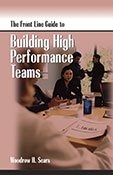THE FRONT LINE GUIDES TO...

“Communications” is an identifiable, observable, and replicable set of skills and competencies that managers can use to assist any group of people to perform more effectively, regardless of their tasks. Communicating well is an enabling skill with amazing potential for positive consequences, both professionally and personally.This book will be your personal companion on the road to becoming a really effective communicator.
You will be prompted to try small developmental tasks that can lead to improvements throughout the full range of your professional and personal activities, as reflected in the communicative abilities, skills, and practices commonly associated with highly-effective leaders.
Your ability to communicate can always be improved, and the best thing is that the pay-off is frequently immediate and obvious.
You will be prompted to try small developmental tasks that can lead to improvements throughout the full range of your professional and personal activities, as reflected in the communicative abilities, skills, and practices commonly associated with highly-effective leaders.
Your ability to communicate can always be improved, and the best thing is that the pay-off is frequently immediate and obvious.

Thinking clearly must precede effective action, and sometimes that challenges usual procedures.It can force people to account for inadequate performance and others to yield leadership roles. In organizational life, those who think clearly may become the focus of resentment and retaliation, because thinking clearly often leads to simplification of processes, better, faster, and cheaper results, and that can lead to downsizing or reorganization. Even in this knowledge economy, many people are stuck in old ways of thinking and working, and change is threatening for them.
But like a hot knife through butter, thinking clearly can cut through inefficient procedures, wasteful processes, and missed opportunities. It’s a powerful weapon in the contest for personal and corporate survival.
But like a hot knife through butter, thinking clearly can cut through inefficient procedures, wasteful processes, and missed opportunities. It’s a powerful weapon in the contest for personal and corporate survival.

Listen to the purveyors of training courses, and theirs are the winners in the management mastery sweepstakes. They can’t all be right. Maybe they’re all wrong. Managers often forget their real role when they run into the rat hole of “people problems” and motivation. What’s the manager’s real role?
Your job is not to manage people, but to manage only three things: schedules, costs, and quality.
What about people? They’re resources! The fact that people are resources does not diminish them in any way. In fact, when managers are held to schedule, cost, and quality targets, they’re more likely to involve their workers, to tap into that enormous reservoir of abilities and experience.
That’s a large part of the job, and this book shows you how to build these powerful, productive relationships.
Your job is not to manage people, but to manage only three things: schedules, costs, and quality.
What about people? They’re resources! The fact that people are resources does not diminish them in any way. In fact, when managers are held to schedule, cost, and quality targets, they’re more likely to involve their workers, to tap into that enormous reservoir of abilities and experience.
That’s a large part of the job, and this book shows you how to build these powerful, productive relationships.

Few people watch anyone as closely as workers watch their managers.They look for the cues and clues that allow them to predict the manager’s mood. They know more about your behavior-- your management style--than you think. A winning management style is not about becoming less predictable, but about becoming more consistent and more congruent. This will remove many of the barriers between you and the people you manage and eliminate their need to waste energy trying to read your moods.
You already have a management style, a set of patterned behaviors that you use in dealing with people and situations.This book will give you tools to read and modify your patterns so you can create a winning interpersonal style and become a more effective manager.
You already have a management style, a set of patterned behaviors that you use in dealing with people and situations.This book will give you tools to read and modify your patterns so you can create a winning interpersonal style and become a more effective manager.

"Team” is one of those four-letter words that’s been so over-used that it has no meaning. Some professional literature and the promotional claims of team-building consultants suggest that it’s an all-purpose, organizational elixir. Poor productivity? Build a team! Poor morale?Have a team-building ramble through the woods. Interpersonal conflict among office staff? Team building will cure it. Sales sagging?Suspend the sales force from ropes on the face of a rock. Customer complaints? Try team building to create savoir faire.Has there ever been more snake-oil being sold as a cure-all? There’s a legitimate time for team building, and it’s not based on training episodes.
This book can empower you to make a positive difference in the lives of many people.
This book can empower you to make a positive difference in the lives of many people.
